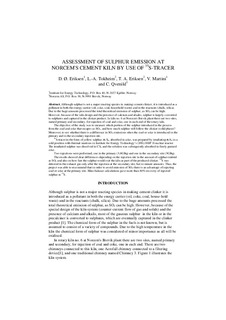| dc.description.abstract | Although sulphur is not a major reacting species in making cement clinker, it is introduced as a pollutant in both the energy carrier (oil, coke, coal, household waste) and in the reactants (chalk, silica). Due to the huge amounts processed the total theoretical emission of sulphur, as SO2 can be high. However, because of the kiln design and the presence of calcium and alkalis, sulphur is largely converted to sulphates and captured in the clinker product. In kiln no. 6 at Norcem's Brevik plant there are two sites, named primary and secondary, for injection of coal and coke, one in each end of the rotary kiln. The objective of the study was to measure which portion of the sulphur introduced in the process from the coal and coke that escapes as SO2, and how much sulphur will follow the clinker (solid phase)? Moreover, to see whether there is a difference in SO2-emissions when the coal or coke is introduced in the primary and in the secondary injection site. 35S-tracer in the form of yellow sulphur, α-S8, absorbed in coke, was prepared by irradiating α-S8 in a cold position with thermal neutrons in Institute for Energy Technology’s (IFE) JEEP II nuclear reactor. The irradiated sulphur was dissolved in CS2 and the solution was subsequently absorbed in finely grained coke. Two injections were performed, one in the primary (3,8GBq) and one in the secondary site (3GBq). The results showed clear differences depending on the injection site in the amount of sulphur emitted as SO2 and also on how fast the sulphur would exit the kiln as part of the produced clinker. 35S was detected in the exhaust gas only after the injection at the secondary site, but in minute amounts. Thus, the project was able to recommend that in order to avoid emission of SO2 there is an advantage of injecting coal or coke at the primary site. Mass balance calculations gave more than 80% recovery of injected sulphur as 35S. | |
